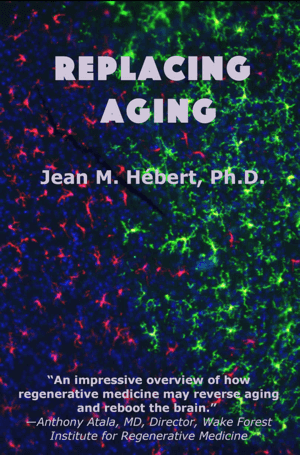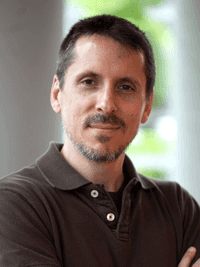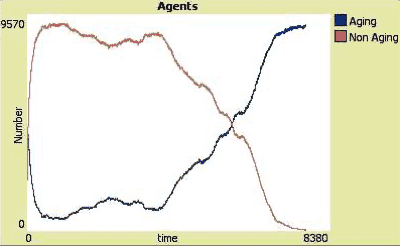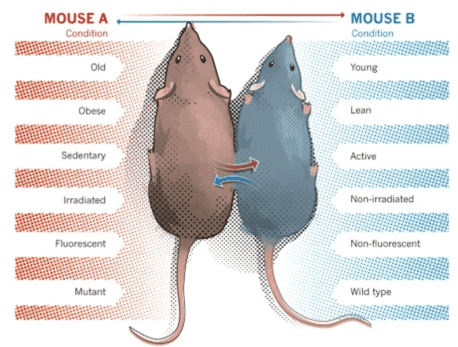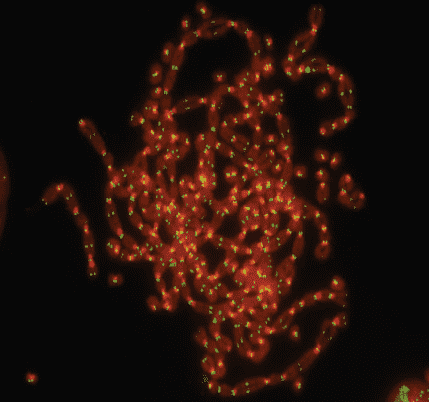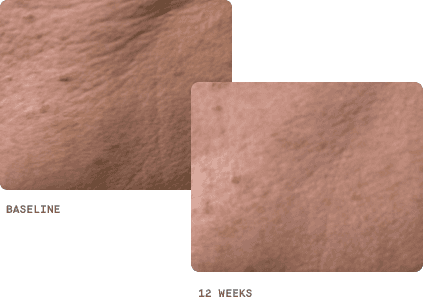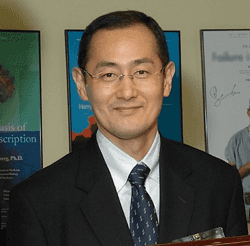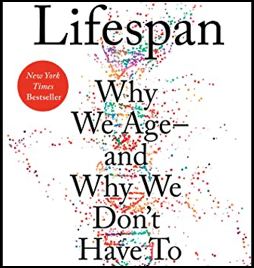- When will AI surpass Facebook and Twitter as the major sources of fake news? – May 23, 2023
- The evolution of aging – May 7, 2023
- The (new) telomere theory of aging – April 15, 2023
Interestingly, Aubrey de Grey, the doyen of the gerontology community, praises the book in the intro (p.3):
The central point made by this book is one of those fulcrums of comprehension on which all important progress depends: obvious to those who understand it, yet incongruous to those who do not. Rejuvenation is damage repair, and replacement and repair are the same thing viewed at different scales. Hebert’s articulation of this principle is the best yet.
This is a bit of surprise, considering that Hébert basically claims that all the research de Grey has supported with his SENS Research Foundation in the last 20 years or so has been kind of pointless, at least with regard to finding a cure for aging. Perhaps de Grey was pleased to see a new book published that supports his wear-and-tear theory of aging, a theory that has come under attack by several high-profile scientists in recent years.
But let’s see what Hébert has to say about the different theories of aging and why they won’t help to undo aging.
Repairing damage
As mentioned above, Hébert supports the wear-and-tear theory of aging. This theory claims that metabolism causes the accumulation of damage, which is the reason why we age. More precisely, we are talking here of damaged macromolecules such as proteins, DNA, fats, and carbohydrates. The chemical reactions that cause this damage include glycation, racemization, deamidation, depurination, depyrimidination, crosslinking, breakage of polymer chains, and so on. You don’t have to know all these chemical processes to understand the argument. Just imagine an organism as a machine where more and more screws and wheels break as the machine hums along.
The machine analogy limps a little because living organisms have built-in repair mechanisms, whereas a machine needs external help to get things fixed. But just like your car mechanic, those biochemical repair processes are not perfect. This means that over the years, more and more unrepaired stuff accumulates. That’s aging—or so goes the theory.
Thus far, Hébert agrees with de Grey and the rest of the old guard of the anti-aging community. However, de Grey and Hébert drift apart when it comes to finding a solution to the problem. Whereas de Grey mostly counts on the invention of new technologies that get rid of all this damage, Hébert argues that all these attempts are futile.
He sees two possible major strategies to cope with the molecular damage: removing the damaged molecules and/or improving our built-in repair mechanisms. This is his argument against the first strategy (p. 52):
The suggested strategies for erasing these forms of damage, however, rely heavily on technologies that have either not yet been shown to be effective or have not yet been developed, such as enzymatic removal of intracellular debris and immune removal of extracellular debris. While these ideas are innovative, there is no way to know at this time how long they will take to develop or whether they will effectively curb enough damage without causing deleterious effects to significantly extend lifespan.
To paraphrase, this means that 20 years of research hasn’t shown much progress in the attempt to find new technologies to get rid of all the cellular and extracellular damage.
The second strategy appears perhaps to be a bit more promising. It’s like giving our car mechanics a bit of extra cash to make sure that the repairs don’t leave any scratches behind. But Hébert doesn’t like this approach either (p. 21):
The problem, as discussed, is the complexity (and in some cases irreversibility) of different types of damage. This makes enhancing overall repair exceedingly challenging at best, particularly because each type of damage requires a different type of repair machinery.
Yes, organisms are a bit more complex than cars (de Grey’s favorite analogy in explaining his endeavors to laymen).
I see two different arguments here. The second one in the above citation is that some damage is “irreversible;” that is, even if our repair machinery were perfect, some damage would always remain.
Unfortunately, Hébert does not mention which kind of damage is in his view irreversible and, more importantly, why this damage is irreversible. There is no scientific law that forbids the reversal of every physical process in an open system with enough external energy flowing into the system. Thus, the second law of thermodynamics, which is often cited when it comes to irreversible processes in aging, cannot explain why damage accumulates and why this damage should be irreversible.
However, his main point here is that the complexity of the repair machinery is the reason why an intervention is beyond our technical abilities. Because the repair processes are determined by our genes, we would have to manipulate many genes, which might have unintended consequences (p. 22):
As discussed in more detail in Chapter 5, the different rates at which damage accumulates across short and long-lived species is likely determined by a large number of genes shaped by evolution over millions of years. To render humans “non-aging” might therefore mean manipulating many genes or genetic pathways all at once. The know-how to do so without disrupting any of the existing finely tuned and intertwined life-sustaining processes is presently lacking.
Unfortunately, Chapter 5 doesn’t really offer more details. It only repeats the argument with different words without discussing the particular biological repair mechanisms that are mentioned here.
The second reason why Hébert believes that this approach is too complex is because we would have to manipulate the trillions of cells in our bodies. I suppose he thinks that gene therapy isn’t an option. The term “gene therapy” does not even appear in the book. This is amazing considering that this approach is currently one of the hottest topics in the gerontology community.
Hébert’s complexity argument is difficult to attack because he does not provide any biochemical details. It is a little like claiming we will never be able to build a Mars colony because life on planet Earth is just too complex and we won’t be able to rebuild this on Mars anytime soon. However, as soon as someone starts to list the necessary resources that Mars lacks, such as an oxygen atmosphere, sufficient amounts of water, arable land, and so on, someone else comes along with a possible solution. Nevertheless, what speaks to Hébert’s point is that the damage repair approach hasn’t really made much progress in recent decades (even though de Grey likes to claim the opposite in every public presentation).
Extending telomeres
Hébert’s arguments against another popular approach, which is based on the telomere theory of aging, are a bit odd, to say the least. Because I discussed the theory several times in this blog, I won’t repeat it here. Instead, I’ll get directly into Hébert’s reasoning. Here are his arguments as to why telomere shortening cannot be a key factor for aging (pp. 33–34):
- There is little to no evidence that telomere shortening causes macromolecular damage or that lengthening telomeres reduces this damage.
- Cellular senescence caused by telomere shortening does not imply that those cells accumulated damage.
- Lengthening telomeres does not extend maximal lifespan.
- Some cells don’t divide (neurons, for example), and extracellular components do not consist of cells, which means that telomere shortening cannot be the cause of aging in these cases.
Let me start with the last assertion. Although it seems to be the most self-evident argument, it is perhaps the weirdest argument of all. Does Hébert really believe that a Nobel laureate such as Elizabeth Blackburn, who favors the telomere of theory aging, does not know that neurons don’t divide? Neurons are very much dependent on glial cells. In fact, neurons can neither function nor survive without the support of glial cells. Because glial cells do divide and therefore feel the effects of telomere shortening, it is obvious that neurons are also affected. The same argument applies to the extracellular matrix (ECM). Of course, dividing cells create the ECM. Once those cells age because of telomere shortening (and other causes such epigenetic changes), they can no longer build the ECM or repair the accumulating damage.
The first two arguments (in the list above) against the telomere theory of aging have one common flaw. They presuppose that aging is all about accumulating damage by the wear and tear of metabolism. Thus, what cannot be the cause of damage cannot be the cause of aging.
I suppose there is not one supporter of the telomere theory of aging that wouldn’t acknowledge that damage accumulates with aging. However, explaining the cause of damage is not enough. A complete theory of aging must also explain why this accumulating damage is not repaired or replaced because damage repair at the cellular and tissue levels is a defining factor of life itself. (Scratch your skin and observe what happens.)
All theories that challenge the wear-and-tear theory argue that there must be mechanisms at work that impact the damage repair capabilities as we age. (Scratch your skin again 20 years later and notice how much longer it takes to heal.) The main contribution of telomere shorting here is probably cellular senescence. You will hardly find a gerontologist who wouldn’t admit that senescent cells cause damage in non-senescent cells. Thus, Hébert’s claim that cellular senescence and therefore telomere shortening does not contribute to damage is simply not true.
The third point, that is, that telomere lengthening does not extend maximal lifespan, is false as well. Elizabeth Blackburn’s book discusses a myriad of studies that prove that telomere lengthening does extend the lifespan in humans. Of course, this does not mean that you would live forever if you kept your telomeres in shape and length. However, nobody claims that telomere shortening is the only cause of aging.
Conclusion
Hébert attacks other theories of aging and ways to combat aging according to these theories. There is a chapter about the genetics of aging and one about caloric restriction. For epigenetic explanations, currently the hottest theories in gerontology, he spares only one page in the book. I found most of the arguments against these approaches as weak as the two that I discussed in this article. His strongest argument is that gerontologists who claim that they will be able to cure aging underestimate its complexity. Time will tell whether he is right about this point.
In my view, the book clearly shows that Hébert is more a neuroscientist than a gerontologist, even though he focuses on research that is supposed to find methods to remedy age-related degeneration in the neocortex. Many of his claims appear to be outdated, as if he weren’t aware of the latest research in the field. Nevertheless, I still recommend reading the first half of the book, even if only to challenge your own favorite theory. Often you can learn more from people who disagree with your views than from those who only confirm your opinions; even if you don’t change your beliefs, it helps to sharpen your concepts when you try to reveal the flaws in your opponent’s arguments.
Nevertheless, the really interesting part is the second half of the book, where Hébert’s own expertise comes to light. If, after reading this post, you got the impression that Hébert believes that fighting aging is a hopeless endeavor, you will be pleased to hear that the opposite is true. His approach just differs quite a bit from all the proposals put forward by gerontologists. I will cover Hébert’s ideas to significantly extend the human lifespan in my next post.

